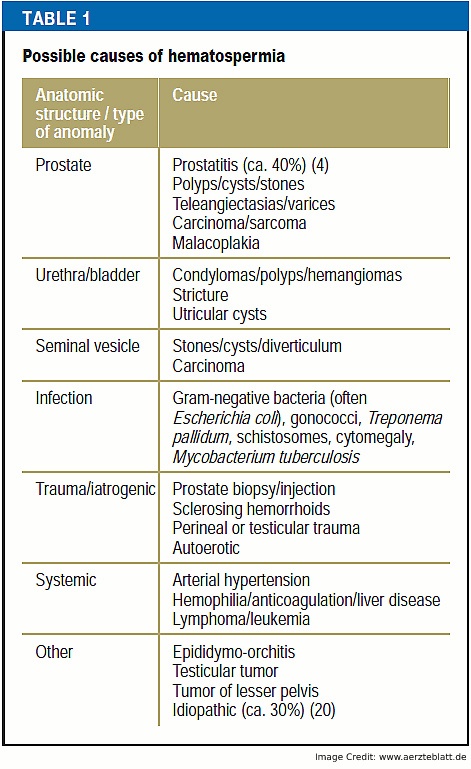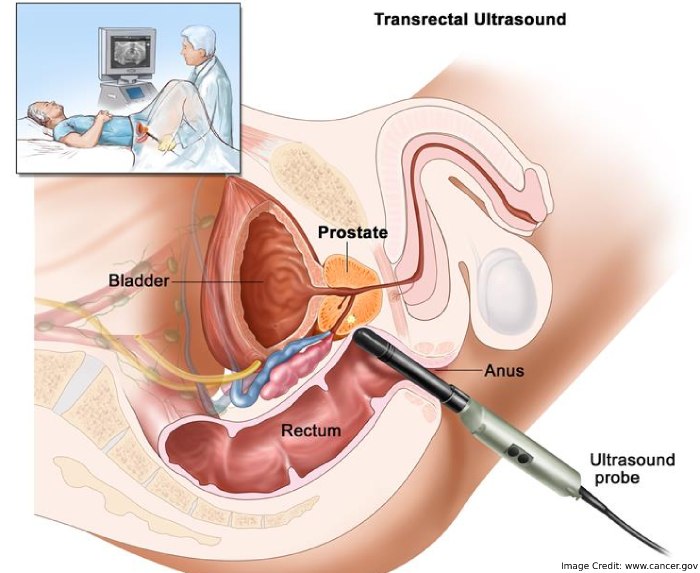Hematospermia (hemaspermia) refers to a male condition where there is a presence of blood in the semen. The state is rarely noticed, and therefore it becomes hard to estimate its incidence.
Experiencing the symptoms of this condition can make any man anxious, but the truth is that having blood in the semen does not always mean that you are suffering from a major medical issue.
Hematospermia is associated with many possible causes, which means that it should not be ignored. Blood in the semen disappears on its own for younger men who are less than 40 years and have no risk factors or related symptoms of the underlying health conditions.
However, evaluation and treatment are needed for men above 40 years of age, as the chances of suffering from Hematospermia are higher than in younger men.
Men with higher chances of having blood in the semen include men with recurring episodes of blood in the semen, men with a bleeding disorder, the risk of cancer or other conditions and men with similar symptoms while ejaculating or urinating.
Hematospermia can be a beginning symptom unlike the widespread belief that it is always an indicator of a severe medical condition such as prostate cancer.
This is usually common to healthy young men, especially those who do not have many risk factors for severe urological diseases[1]. In such cases, the symptom is likely to disappear on its own even without seeking medical attention.
However, it is advisable to have a basic diagnostic evaluation even after a single episode of the condition.
What are the Causes of Hematospermia?
There are many conditions that are associated with causing blood in the semen. Usually, these conditions affect the male genitourinary system organs such as the urethra, bladder, testicles and seminal vesicles, which are the tubes that distribute the semen to the testicles.
Besides, it also includes the prostate and the epididymis, which are the ducts that store, mature and transports the sperm.
In most cases, blood in the semen is associated with the outcome of a prostate gland biopsy. This is because studies have shown that most of the men that have undergone a prostate biopsy may experience some blood in the semen that might last for three to four weeks.
Similarly, studies have shown that blood in the semen can also be as a result of vasectomy, which usually persists for approximately seven days after the procedure.
When it comes to Hematospermia for patients who have not had a vasectomy or prostate biopsy in the recent past, the cause may be many benign and malignant infectious male genital system conditions.

However, in most cases, doctors are unable to find any definitive reasons for the condition. Some of the common conditions[2] associated with Hematospermia include:
1. Inflammation or Infection
According to most doctors, infection and subsequent inflammation in the body is the common the most common cause of Hematospermia.
The condition can happen due to the infection or inflammation in any of the glands, ejaculatory ducts and tubes that produce and transport seminal fluid and the sperm from the body. These include:
- Urethra: This refers to the tube that acts as the passage of urine and semen from the penis
- Prostate Gland: This gland produces the fluid part of the semen
- Seminal Vesicles: These add more fluid to the semen
- Vas deferens and Epididymis: This refers to tiny tubes where the sperm mature
2. Broken Blood Vessel in The Urethra
If the blood vessels in the urethra are broken, this will be another likely cause of blood in the semen as the urethra acts as the passage of sperm and seminal fluid. This means that the blood can leak into the passage if the blood vessels are broken and mixed with the semen.
In most cases, a doctor or urologist checks on the medical history of the patient by asking whether he has undergone prostate surgery or radiation cancer treatment recently.
This is because these are the most common causes of broken blood vessels in the urethra. However, it is good to understand that if this is the case, then the condition will soon disappear on its own.
3. Trauma or a Medical Procedure

Studies have shown that blood in the semen is common to men who have undergone medical procedures. For instance, four out of five men who undergo prostate biopsy have blood in the semen for some days.
Moreover, research has shown that treatment procedures that are done to overcome urinary issues may cause severe trauma, which might lead to irregular bleeding. These include vasectomy, radiation therapy for cancer treatment and hemorrhoids injections.
Likewise, blood in the semen can also result from physical trauma to the sex organs after an injury to the testicles, pelvic fracture, excessive masturbation or sexual activity or any other injury.
4. Sexually Transmitted Infection
The other major cause of the blood in the semen is some sexually transmitted infections such as gonorrhea or Chlamydia. This is because the urogenital system[3] is susceptible to viral and bacterial infections that account for about four out of ten cases of Hematospermia.
5. Tumors and Polyps
A study carried on 900 patients with Hematospermia, shows that about 3.5 percent of the patients had a tumor, which was mostly in the prostate gland. However, the condition can also be associated with cancer of other urological organs such as the cancer of bladder, testicles and other urinary tract and reproductive organs.
Therefore, it is important for cases of blood in the semen to be evaluated in time, especially for older men as they have cancer risk factors, which is a life-threatening disease if not treated.
6. Obstruction of The Ejaculatory Ducts
Obstruction of any of the ducts or the tiny tubes in the reproductive system might lead to the breaking of the blood vessels. Congenital or acquired cysts of the seminal vesicles are the major cause obstruction of the ducts.
The breaking of the blood vessels causes leaking of blood to the semen. For instance, blood in the semen is linked to the condition that causes the prostate to enlarge and damage urethra.
7. Other Severe Medical Conditions
Other serious diseases such as leukemia, HIV, high blood pressure, liver disease and other medical conditions are also linked to the blood in the semen.
However, it is essential to understand that about 15 percent of the cases of Hematospermia cannot be traced to any known cause. Fortunately, most of these cases disappear on their own without any medical intervention after some days.
What are the Diseases Associated with Hematospermia?

Some of the conditions associated with blood in the semen include the following:
- Infections such as Chlamydia, trichomoniasis, herpes, and cytomegalovirus
- Malignant or benign tumors of the testes, bladder, prostate and the seminal vesicles
- Inflammation of the urethra (urethritis), prostate (prostatitis), or epididymis (epididymitis)
- Polyps in the urethra
- Metastatic cancers of the areas within the genitourinary system, which include the ones that spread from other parts of the body
- Calculi stones in the prostate or the seminal vesicles
- Cysts, bleeding or other abnormalities in the seminal vesicles
- Ejaculatory ducts obstruction
What are the Risk Factors Associated with Blood in the Semen?
There are many factors associated with Hematospermia, and they include the following:
- Sexually transmitted infections such as gonorrhea, Chlamydia and much more
- Medical procedures such as prostate biopsy
- Prolonged abstinence
- Excessive sexual activity
- Masturbation
- Trauma
- Certain medical conditions such as high blood pressure, liver disease, and leukemia
- Age (studies have shown that cases of severe cases of blood in the semen are higher for men above 40 years)
- Obstruction of the ejaculatory ducts and tubes
What are the Common Symptoms of Hematospermia?

Unlike other conditions that do not show any symptoms, blood in the semen is a condition that can be detected and treated early.
This is because several symptoms are associated with blood in the semen. The symptoms are not inclusive but mainly depend on the underlying cause[4]. Some of the common symptoms that can occasionally accompany the condition include:
- Blood in the urine
- Pain during urination
- Lower back pain
- Pain during ejaculation
- Fever
- Swelling in the scrotum and /or testes
- Tenderness in the scrotum and /or testes
- Tenderness or swelling in the groin region
- High blood pressure
- Penis discharge or other STD signs
- Racing pulse
How is Blood in the Semen Condition Diagnosed?

There are many tests available that can be used in evaluating Hematospermia. These include clinical history and physical examination as well as other diagnostic tests that are carried out to confirm the outcome of these two evaluation methods.
Some of the standard diagnostic tests to identify patients with the condition include urinalysis, cultures, semen analysis and imaging studies.
Clinical History: Checking the medical history of the patient is the first diagnostic test that can dispel or confirm Pseudohematospermia. This refers to a condition where the person affected misinterprets by the blood from the sexual partner or blood in his urine (macrohematuria).
The doctor should ask questions and establish the duration and development of the symptoms such as pain on ejaculation, erection or penetration, pain in the perineal or genital area[5] as well as any other factor that may cause the condition.
According to studies, micturition disorders such as Algeria, pollakiuria, and urinary stream weakening may be a sign of lower urinary tract infection.
Besides, this could also be caused by iatrogenic factors such as medical procedures, medication, excessively rough sexual activity or trauma from a previous incidence. These aspects might require being evaluated though it depends on patient’s age as earlier mentioned.
Medical Examination: Medical examinations that show higher than normal blood pressure or fever may indicate an infection or systemic cause. These also include examination and inspection of the external genitals like the epididymis or the sperm ducts.
Besides, the doctor should examine the superficial inguinal ring together and the neighboring lymph nodes as well as perform a digital examination of the seminal vesicles and the prostate.
Other Medical Tests: The semen should be examined microscopically and macroscopically whenever possible. Microscopic examination of the semen can help in differentiating between semen discoloration due to other factors and the real Hematospermia.
The doctor can also suggest ejaculate cultures specifically for patients where the cause is suspected to be tuberculosis though it is rarely productive for other cases. Besides, semen analysis should also be performed for schistosomiasis suspicion.
Urethral swabs examination and urinary sediment are also important. Moreover, urine cultures can also be harvested after prostatic massage if is necessary but the test rarely demonstrate the pathogens.
Blood count and coagulation parameter analysis can be done in case of suspicion of a coagulation disorder or an underlying infection or anemia.
Moreover, a test can be carried out to determine uric acid to exclude cases of hyperuricemia while the PSA of men with over 40 years should also be measured.
PSA testing involves measuring prostate-specific antigen in the patient’s blood to confirm suspicions of prostate cancer.
Imaging Studies: Imaging studies include tests such as MRI or ultrasound may help reveal tumors or other abnormalities. Some of the common imaging studies include:
1. Transrectal Sonography

This is the first imaging method for diagnosing the condition, which is a safe, affordable and minimally invasive method of inspecting the structures that may be affected.
Studies have shown that TRUS is effective in investigating the causes of Hematospermia though the research was done with a low number of participants. Moreover, the method simultaneously helps in enabling biopsy of the prostate areas.
A study by Zhao was able to confirm the effectiveness of TRUS as a reliable method of diagnosing Hematospermia.
The study revealed that more than 80 percent of 270 Hematospermia patients had visible pathology although the authors could not demonstrate clearly that the results were the cause of the condition.
Furthermore, another study published by Raviv was able to identify an anatomical correlate as a factor in a group of more than 100 participants using TRUS.
2. Invasive Transurectral Vesiculoscopy
This is another imaging study method that has shown clear indications that it could be more effective in diagnosing Hematospermia than TRUS. This diagnostic procedure involves inspecting the ejaculatory ducts that open at the verumontanum, which is the central segment of the urethra.
However, the method is largely still experimental. According to a prospective study done on 106 patients, TRUS was able to demonstrate the cause of Hematospermia in 45.3 percent while transurethral vesiculoscopy demonstrated the cause in 14.5 percent of the men taking part.
The combination of the two procedures was able to show 87.7 percent of the cases. Some of the common diagnoses confirmed by the tests include obstructions, strictures and stones or calcifications.
3. Magnetic Resonance Imaging (MRI) or Computed Tomography(CT)
According to the recent studies, magnetic resonance imaging or computed tomography is one of the most indispensable methods for diagnosing Hematospermia, especially when combined with an endorectal coil.
This is because the MRI can help in identify and localized male adnexa calcification or cysts as well as differentiate between older and recent bleeding. Besides, MRI has shown enough indications that it can be useful in identifying prostate cancer cases.
The MRI was able to identify a morphological correlate as the cause of bleeding in a retrospective analysis done on 88 patients with Hematospermia. This was a signal or volume increase of the male adnexa in the form of cysts, which later confirmed by urethral vesiculoscopy.
4. Condom Test

This helps in establishing whether that blood in the semen is from the menstrual cycle of your sexual partner. The doctor will suggest that the man wears a condom and then the protected semen is examined to determine the presence of blood.
5. Cystoscopy
Cystoscopy is another reliable diagnostic method that able to locate the specific site of the bleeding. This means that the procedure can detect urethral disorders such as anomalies like stones or polyps, vascular or prostatic cysts anomalies and structures.
Besides, the method allows the condition to be treated with visual control. This procedure may require parallel prostate massage as it helps in localizing the bleeding source.
What are the Major Treatment Methods for Hematospermia?
There are many treatment methods for blood in the semen depending on the underlying cause. In some cases, a patient is given a treatment with antibiotics for a presumptive diagnosis of prostatitis, which is the inflammation of the prostate gland.
This is because studies have shown that a quarter of the cases of men with Hematospermia suffer from the inflammation of the prostate. However, there has not been a definitive establishment of the benefits of such treatment.
It is also important to understand that if the condition is not associated with any known abnormality of other devastating symptoms, the issue is taken as a self-limiting problem that can disappear on its own without medical attention.
This is mostly the case with younger men where the condition happens once or twice without other symptoms or a history of medications. However, a doctor may refer you to a urologist if you experience repeated episodes of Hematospermia that is accompanied by painful urinary or ejaculatory symptoms.
Moreover, if the doctor suspects that the patient has prostate cancer or any other form of cancer, the medical expert can suggest a prostate biopsy. This helps in evaluating the tissue for cancer. Prostate cancer incidence is low among men younger than 45 years as it only accounts for only 0.5% to 0.6%.
However, when it comes to men with risk factors for cancer, performing a test to confirm prostate cancer suspicion may be the most reassuring way to treat Hematospermia. Finally, if the diagnosis indicates that STD or other medical conditions such as liver disease or high blood pressure is the cause, then the doctor will treat the condition.
What are the Complications Associated With Hematospermia?
In most cases, the condition of the blood in the semen is self-limiting and therefore does not need any medical intervention. However, in some patients, Hematospermia may be a sign of systemic disorders or other urological diseases.
With the many diagnostic tests such as the imaging studies, doctors can detect the condition and treat it early. These include the transrectal ultrasonography and other diagnostic methods mentioned above.
Is there Ways to Prevent Hematospermia?

It is important to understand that it is hard to prevent Hematospermia as various factors cause the condition. This includes infections due to sexually transmitted diseases that affect the urethra and urethral strictures.
Therefore, the major method of preventing the risk of Hematospermia is ensuring that we only engage in safer sex or abstain from indiscriminate sex.
Moreover, the blood in the semen is not contagious, but if the underlying cause is due any sexually transmitted disease, then the infection may be contagious.
Therefore, it advisable to avoid getting into contact with blood in the semen as this also a significant way that others develop the risk of Hematospermia.
Read Next: Aspermia – The Key Things You Need to Know
What is the Outlook (Prognosis) for Hematospermia Patients?
The outlook for Hematospermia depends on the underlying cause of the blood in the semen for causes that are identifiable.
Identifying the performing further tests such as imaging studies that offers a better way to exclude or detect potential causes of Hematospermia, especially for malignant ones.
Hematospermia is a potentially alarming occurrence, but fortunately, most cases blood in the semen are benign and therefore disappear without any need for medical intervention[6]. This is because even though some cases are related to cancer, cancer is still a rare cause of Hematospermia, especially for younger men below 40 years.
In some cases, the condition might be hard to detect as the blood in the seminal fluid with a naked eye. Besides, you might also misinterpret blood from your sexual partner for Hematospermia, but this can be confirmed by the diagnostic tests mentioned above.
The patient can also rely on the effect of the color of the semen to determine the time that has elapsed since bleeding occurred. In this case, light red to brownish color indicates that the event has just occurred, while darker blood clots mean that some time has elapsed since bleeding took place.
Feature image: Shutterstock.com
In-Post Image: Shutterstock.com, aerzteblatt.de & cancer.gov









 This article changed my life!
This article changed my life! This article was informative.
This article was informative. I have a medical question.
I have a medical question.
 This article contains incorrect information.
This article contains incorrect information. This article doesn’t have the information I’m looking for.
This article doesn’t have the information I’m looking for.